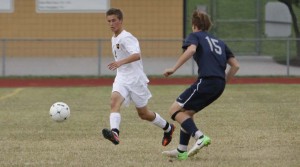 Work will start on FHN’s turf field after the spring sports season with an expected start date of May 25. The company Byrne and Jones Sports was chosen by the District to complete the project. Cost is estimated at about $1.4 million for both fields at FHN and FHC.
Work will start on FHN’s turf field after the spring sports season with an expected start date of May 25. The company Byrne and Jones Sports was chosen by the District to complete the project. Cost is estimated at about $1.4 million for both fields at FHN and FHC.
“District administrators looked at several sites to evaluate the product of the company, as well as the craftsmanship of the field,” Director of Operations and Facilities Rick Pavia said. “Then we look at the actual cost, as well as the cost of replacement of the field.”
At the District level, talks for a turf field first started in 2011 where the plan was placed on the District long range strategic plan. In 2012, planning and funding began. This decision first went through the District Facility Committee, then the Board of Education. The Byrne and Jones company was chosen by the District for their price, craftsmanship and value. This company has also completed over 80 fields for places like Westminster Christian Academy, the Saints’ stadium, the Broncos’ stadium and Mizzou.
“The benefits are the amount of uses for the facility go up much higher, and there is a more consistent playing surface,” Project Manager Jameson Sheley said.
The estimated time to completely finish the field is three months, with both FHN and FHC’s field being worked on simultaneously. The first step to this new field would be the initial dirt work to remove the current grass. The soil will then be stabilized and drainage will be installed. Fabric will be placed to cover the entire field, and base rock will be spread out across the fabric. Surface stone is then applied and rolled out to create a smooth surface. The initial work takes a team of about three to five people.
Once the base is ready, turf is roll out strip by strip beginning at the middle of the field. The seams are then sewn and harks marks and numbers are installed. The final step is installing the rubber and sand infill. This process takes about a team of six to eight workers.
“It’s the newest and greatest technology,” Athletic Director Mike Janes said. “I like grass, but we will be able use the turf so much. It’s all about perception. It makes the school look better.”
Since 1986, FHN has been using a grass field to house all sporting events. According to Janes, the downfall to grass fields is maintenance; mowing the grass, marking the field and watching weather conditions, all of which will affect the teams playing on the grass. After both FHN and FHC receive turf, all FHSD high schools will have turf. With this 11 out of the 16 teams in the conference will have turf.
“You’re looking at a multi-use facility,” Janes said. “We don’t have to worry about damaging the field or the weather.”
There are also several health hazards that have been researched in regards to athletes playing on the synthetic turf. One of the main risks is the excessive amount of heat given off of the field according to New Jersey Work Environment Council (WEC). These fields can reach up to 150 degrees Fahrenheit. This may cause burns, dehydration and heat exhaustion. According to Rex Sharp, MU’s head athletic trainer, synthetic turf is to be just as safe as grass. But he agrees that outdoor fields will get hotter under certain conditions. In his experience the artificial fields get at least 10 to 15 degrees hotter under the afternoon sun.
“We already have to deal with heat as it is,” Janes said. “It’s just another thing we have to monitor.”
Even with health hazards, the buzz around FHN shows overall excitement about the new field. Both athletes and coaches have shown support of the new field. According to soccer coach Zach Fettig, turf makes game play a lot faster, and the bounces of the ball are more true. He also feels that it puts FHN on the same playing field as other schools with turf.
“I would prefer to play on grass, but playing on turf gives you a better playing surface,” Fettig said.
As of press time, decision for the design of the field is not final. There are currently five options for the design, four are the same but with different sizes. According to Janes, he hopes to have option one, which is the FHN shield symbol in the center, with “KNIGHTS” written in each end zone. Designs for the field range from $30,000 to $55,000. A final decision must be made by March 1.
“It all depends on the budget,” Janes said. “We want the most that will fit within the budget.”




![St. Charles Main Street Hosts Annual Christmas Traditions [Photo Gallery]](https://FHNtoday.com/wp-content/uploads/2024/12/christmas-traditions_-6-1200x800.jpg)
![Cross Country Celebrates With Banquet [Photo Gallery]](https://FHNtoday.com/wp-content/uploads/2024/12/IMG_8875-1200x800.jpg)


![FBLA and DECA Host Annual Friendsgiving [Photo Gallery]](https://FHNtoday.com/wp-content/uploads/2024/11/18-IMG_4199-1200x800.jpg)
